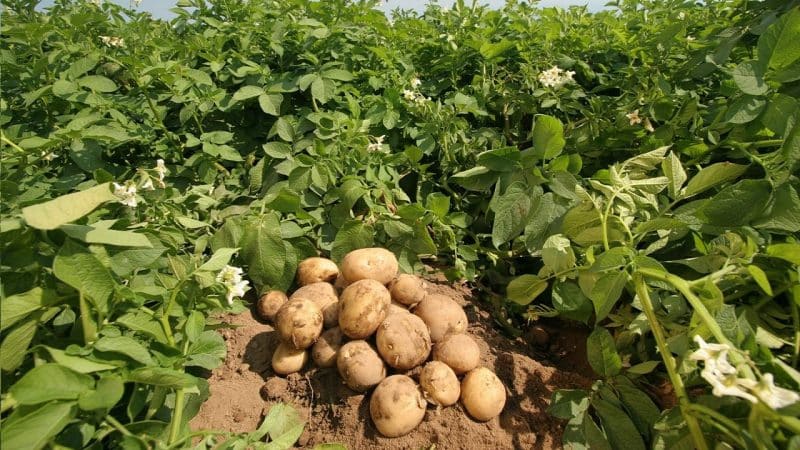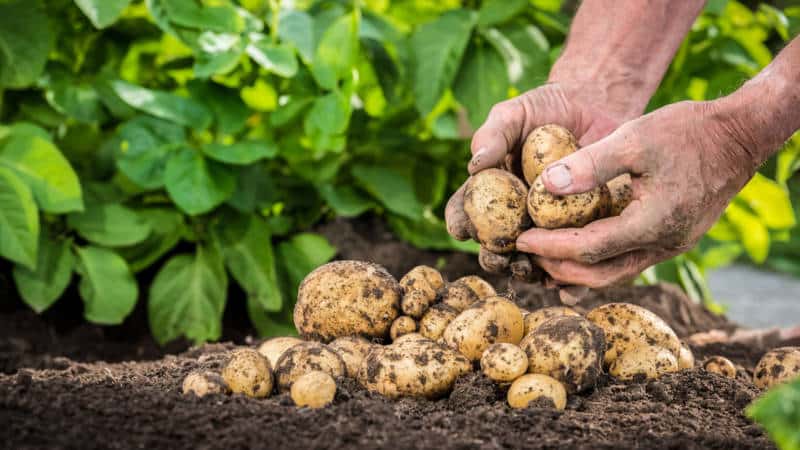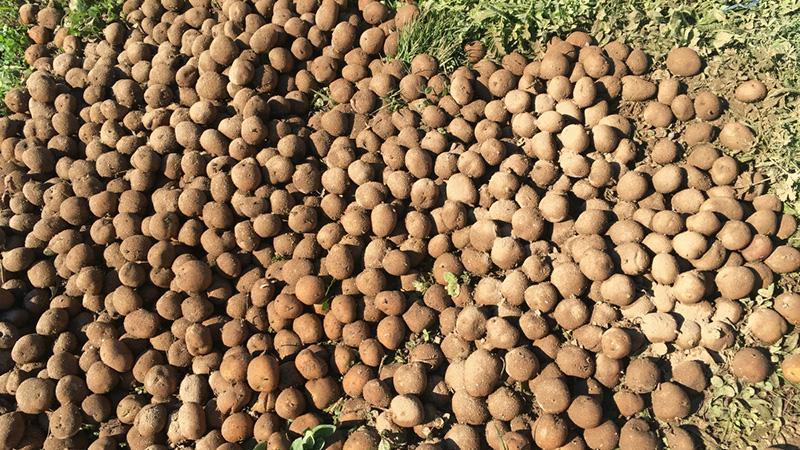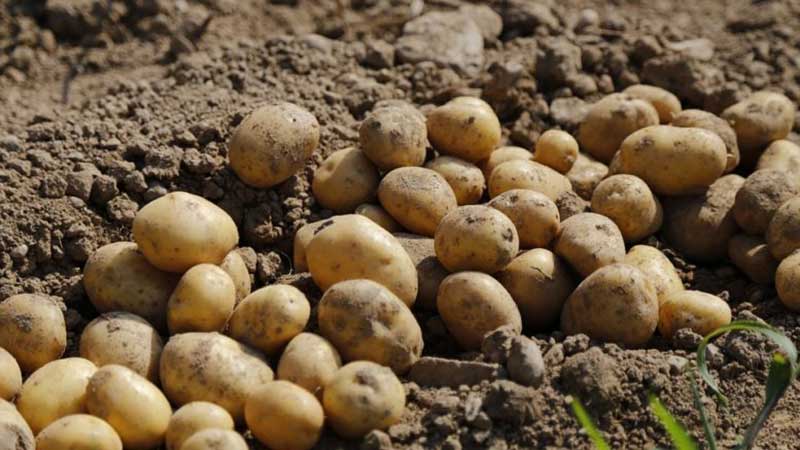We reveal the secrets of record yield: how to grow a bucket of potatoes from one bush
Secrets of increasing potato yields from experienced farmers will allow you to collect a bucket of tubers and more from one bush. Use the recommendations from our article, and your dacha neighbors will watch you with envy through the crack in the fence.
Is it possible to grow a bucket of potatoes from a bush?
They also grow two buckets per bush, depending on which bucket. Seriously, increasing the yield from a potato plant is a completely doable task.
Read our recommendations carefully; you will reap a record harvest even from a small plot.

What does productivity depend on?
The productivity of any crop depends on its care - this is the golden rule of the gardener. Even the most prolific potato varieties can be ruined if these rules are not followed.
Caring for the crop consists of:
- in the selection of seed material;
- in preparing potatoes for planting;
- in proper planting, watering, weeding and correctly selected fertilizers.
Dimensions of grown potatoes
The size of the tubers depends on the variety. Fertile varieties have potatoes weighing from 180 to 500-600 g. The greater the weight of the tuber, the fewer of them on the bush. For example, potatoes of the Udacha variety weigh on average 180 g; 20-25 pieces are collected from one bush, approximately 10 kg per 1 sq. m. m.
Number of potatoes
From 5 to 40 potatoes are formed on the bush, which depends on the variety. It is difficult to increase the varietal number of tubers on a bush. But there is one dependence: the lighter and looser the soil, the easier it is for tubers to set. On clay soil, it is more difficult for roots to break through and for potatoes to develop.
There is a sure sign: the more eyes there are on a potato, the more trunks there are in the bush. The more trunks there are in the bush, the more lush the vegetation. The more lush the vegetation, the better the photosynthesis. The better the photosynthesis, the more nutrients will flow to the tubers. And this gives them maximum growth.

Varieties with which you can achieve such yields
There are several varieties of potatoes with maximum yield. They differ in shape and in the number of tubers on the bush, and the tubers themselves vary in weight. It is quite possible to collect a bucket of potatoes from a bush with these varieties.
- Bellarosa – a variety bred in Slovakia, large, highly starchy with white, crumbly, quickly boiling pulp. Bellarosa has a brownish rind. The variety requires regular watering, this is the only way the potatoes will reach a weight of 500-600 g. From 1 sq. m get 5.5 kg of potatoes.
- Idaho – all fast food chains order it. The large tubers of this variety are perfectly smooth and elongated. Idaho potatoes have an atypical flavor and are nutritious and starchy. The variety is resistant to diseases and is early ripening. From 1 sq. m get 6 kg.
- Gala – an early variety, the bush is only 50 cm high, but the weight of 5-6 tubers per bush reaches 400 g, the rest are twice as small. From 1 sq. m get 7 kg.
- Rosara – a variety with multiple tubers – up to 30 pieces, weighing 150 g. The variety is resistant to diseases and starchy. However, the Colorado potato beetle loves him very much. From 1 sq. m get 4-4.5 kg.
- Luck – productive, large-fruited variety. The average weight is 180 g, there are about 25 tubers per bush. Harvest from 1 sq. m - about 10 kg.
- Slav – variety from Ukraine. Large tubers weighing up to 1 kg. It is unpretentious to the soil, not starchy, but has an inexpressive taste.Used as feed. Harvest from 1 sq. m – 3-3.5 kg.
Reference. Seed material of elite varieties, which in the first seven years will produce only large, tasty potatoes, is created in special laboratories of agricultural firms. They are sold as mini tubers with sprouts. With this material you can collect a bucket from a bush.
How to grow a bucket of potatoes from a bush
Answer: take into account the climatic conditions of the area, the characteristics of the soil, prepare the seeds correctly, care for the plants, and fertilize the beds. Over time, each gardener develops his own secrets for high potato yields, which he actively uses from year to year.
Important! Rarely, only large tubers of equal weight are formed on a bush: there will be both medium and small potatoes, which will be used as seed material for the next sowing year.

Landing rules
Potatoes are planted when two leaves the size of a ruble coin appear on the branches of birch trees.. It is believed that by this time the soil has warmed up to the desired temperature, and the potatoes will grow faster.
Potatoes do not like dense soil, so they dig it up in the fall so that it is loose in the spring. If the soil is dense in the spring, it is loosened rather than dug up. The ridges are formed in the direction from north to south. This will provide them with maximum warmth and light that plants need so much.
Choose the planting method that suits you best.
Method No. 1
Before planting, potato tubers are cut into pieces so that each of them has three eyes with sprouted sprouts. One sprout - one strong shoot. 3-4 of these are planted in a hole.
Plant the sprouted tubers with the sprouts down in the holes. Be careful not to break the sprouts. On heavy soils, the placement depth is 5-8 cm, on light soils – 8-12 cm.The first sprout that appears on the surface is the strongest, it will produce the maximum tubers, the rest will produce “peas.”
The ridges are mulched. This is especially true for regions with heavy loamy soils. For potatoes, straw or mown grass, humus, peat, sawdust, last year's leaves, bark of any trees, cardboard, agrofibre or dark film are used as mulch.
Method No. 2
The potatoes are cut so that there are 2-3 eyes left on each part. Prepare a mixture for processing planting material: take a glass of ash per 10 liters of water, 1 tsp. boric acid and 1 tbsp. l. Bordeaux mixture. The seed material is soaked in this solution for 15 minutes. Dig holes at a distance of 40-50 cm, throw in 1 tsp. "Amofoski." Plant potatoes and dig in slightly.
After the sprouts appear, they are carefully spread apart and each one is sprinkled with earth in a circle. When the stems grow, sprinkle again. The meaning of such planting: the bush is divided into several parts, where each grows separately and does not shade the other, nutrients reach the tubers faster, the potatoes turn out to be large, and the harvest is large.
Secrets of care
With method No. 1, the beds are not hilled, weeded or watered. Mulch retains moisture where there is little of it, prevents weeds from breaking through and maintains the shape of the ridges without exposing the tubers until harvest. With method No. 2, watering and weeding are used as care.
If the potatoes were planted in the usual way, in beds, then in order to collect a bucket from a bush, the potatoes need the following care.
Watering in the evening. Potatoes are watered twice during the growth period: during budding and after flowering, when active growth of tubers begins. When watering, the moisture should reach a depth of 40 cm: this is approximately one watering can for 2-3 bushes.This is the only way water will reach the tubers.
Important! Watering will be unnecessary if the soil is already wet, for example, after rain. Excess moisture will lead to rotting and disease of the tubers.
Loosening the soil. Two loosenings are carried out after watering. The first loosening during budding is carried out to a depth of 2-3 cm, so the roots will receive the necessary amount of oxygen and begin to develop faster. When loosening, the maximum number of weeds is destroyed. The second loosening to a depth of 8 cm is carried out after flowering: the rows are loosened, removing weeds. Such loosening will not damage the tubers and will protect them from pests.
Hill up the plant when the trunk height reaches 15-18 cm. Using a hoe, the soil is pulled up from all sides to each bush until a mound is obtained. Hilling is carried out only on moist soil. A second hilling may be needed if the mounds around the potatoes have moved apart and exposed roots and potatoes.
The best fertilizers
The best feeding for potatoes it is organic. In autumn, rotted manure is added to the soil at a rate of 4-5 kg per square meter. m. If there is no manure, add potassium and phosphorus fertilizers in a 1:1 ratio.
The nutritional menu for potatoes after planting is three times a day of fertilizer per season:
- First feeding during the growing season, especially for thin and weak stems: 15 tbsp. humus is mixed with 10 tsp. urea. This amount is for 10 m of beds.
- Second feeding to stimulate flowering, during budding: 30 tbsp. l. ash is mixed with 10 tsp. potassium sulfate. Again, enough for 10 m.
- The third feeding accelerates the formation of tubers: by 2 tbsp. l. superphosphate add 1 tbsp. l. nitrophoska and all this in 10 liters of water. Pour 0.5 liters per bush.
Do not feed organic matter during the flowering period. This provokes diseases and stimulates weed growth.
Lifehacks from experienced farmers that will help increase your yield

Simple and clear tips for those who want to collect a bucket or two from a potato bush every year. When using this or that method, the rules of reasonableness are observed. If it is clear that a life hack will not suit your situation, do not use it so as not to be left without potatoes in winter.
Crop rotation
The golden rule for annual potato yield: they are returned to the same place after 4-6 years. Good predecessors: lettuce, cucumbers, onions, pumpkin, legumes, radishes. Do not plant after sunflowers, tomatoes, peppers, and eggplants.
How to “drive out” sprouts
1.5 months before landings Potatoes are placed in jars or boxes for germination and sprayed with a stimulant to awaken the buds. Place it in a bright place. 10 days before planting, cover with a dark cloth. The sprouts will emerge in 5-7 days.
How to cut a tuber into eyes
Divide with a sharp knife, after dipping it in brilliant green: this protects the tuber from disease and rotting. After this, dry for 3-4 days in the open air.
Important! If you cut the tubers just before planting, you can anoint them with ash or dip them in cement (in the ground the thin crust simply disappears). These are also good ways to protect against various misfortunes.
Pest protection
Potatoes are protected from the pest by planting beans along the perimeter of the ridges. When they bloom, legumes emit a smell that the Colorado potato beetle is afraid of. The beetle infestation will be minimal.
How to harvest a double harvest
Early potatoes are dug up in early June, large tubers are selected, small ones are left on the roots and immediately dug into place. At the same time, pour a bucket of water into the planting hole and spud it up. The bushes take root in a week, and a second harvest is harvested in the fall.
Tricky break
20 days after flowering, the potato stems are broken at a height of 10-15 cm from the soil. In this case, the stem should not lose its integrity. After such a breakdown, the nutrients that tended to the top “unfold” and will go into the tubers. The tops do not wither, which means photosynthesis is taking place and the vital activity of the bush is not impaired.
Conclusion
Growing potatoes is not an easy task: the crop does not seem to be too demanding, but it often frustrates gardeners by not producing the expected harvest. Using the rules of planting, care and fertilization, which are described in the article, you will save space for planting and at the same time collect a bucket of harvest from each bush. Don't neglect life hacks either. Have a good harvest!